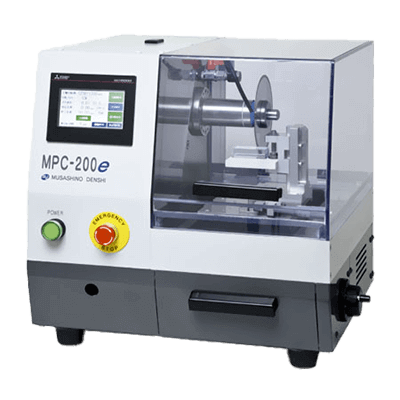What Is a Desktop Cutting Machine?

A desktop cutting machine is a power tool for cutting hard materials such as metals and minerals.
They are capable of precision cutting and are small and light enough to be easily maneuvered for use on a tabletop. They have the advantage of being unaffected by the work environment because of their low vibration and low operating noise.
Desktop cutting machines are available with grinding wheels made of alumina, diamond, or other materials, each with different characteristics. There are many ways to move the blade, such as up and down, back and forth, oscillating cutting, and variable speed cutting, and it is important to select the appropriate one for the application. Although widely used by metalworking companies and factory production lines, they are also popular for DIY and hobby applications. It is also possible to easily perform cutting operations at home.
Desktop cutting machines are characterized by the high cutting force required when cutting hard materials. As a result, the cutting surface is beautifully organized and excellent processing quality can be produced. In addition, because they are used on a tabletop, they are relatively compact in size, making them easy to store and carry around.
Uses of Desktop Cutting Machines
The primary use of desktop cutting machines is for cutting small, hard materials. Examples include jewelry, metal pieces, electronic substrates, and ceramics. Another application is in the field of research and development, where they are used to cut metals and materials for testing and microscopy, as well as to observe cross sections of materials and prepare test specimens.
Industrial applications include the machining of automotive parts, aircraft parts, and construction materials, etc. They are also popular for DIY and hobby uses, such as jewelry making and miniature production, as they allow users to cut and process metal, plastic, and other materials at home.
Principle of Desktop Cutting Machines
A desktop cutting machine uses a cutting blade to cut an object. The lower part of the cutting blade is immersed in the cooling liquid, and the cooling liquid absorbs the high temperature generated during cutting, so that the cooling liquid always enters the contact surface between the blade and the workpiece. This allows for beautifully cut surfaces without burning or deforming the workpiece.
Desktop cutting machines are available in a variety of cutting methods, including cutting blades with up-and-down or back-and-forth motion, oscillating cutting, and variable speed cutting. In the vertical or back-and-forth cutting method, the blade is in contact with the object, and the object is cut by moving the blade. In oscillating cutting, the blade is oscillated so that coolant always enters the cutting area and the surface where the blade is in contact. In variable speed cutting, the rotation speed can be changed to match the hardness of the workpiece.
Other Information on Desktop Cutting Machines
Machines Used in Conjunction With Desktop Cutting Machines
Desktop cutting machines are precision machines suitable for cutting small parts and materials, but they are not complete on their own. In the actual cutting process, they are used in combination with microscopes, polishing machines, grinding machines, washing machines, drying machines, and so on.
Desktop cutting machines are often used as a single process and must be used in combination with other processing machines. It is important to design a process that combines each machine to achieve higher precision.
1. Microscope
Microscopes are often used together with desktop cutting machines. It allows the operator to see the minute details of the workpiece, enabling cutting operations to be performed at precise locations. Also, after cutting, the condition of the cut surface can be checked to ensure highly accurate processing.
2. Polishing and Grinding Machines
For parts and materials cut by desktop cutting machines to be used in the next process, it is important that the shape of the part or material is accurate. Therefore, polishing and grinding machines are used to polish and finish the cut surface after cutting. These machines smooth the cut surfaces to produce highly accurate parts.
3. Washing and Drying Machines
When materials cut by a desktop cutting machine are used in the next process, it is necessary to remove dirt from the surface. Therefore, the use of a washer and dryer together can keep the surface clean and improve the quality of the parts.